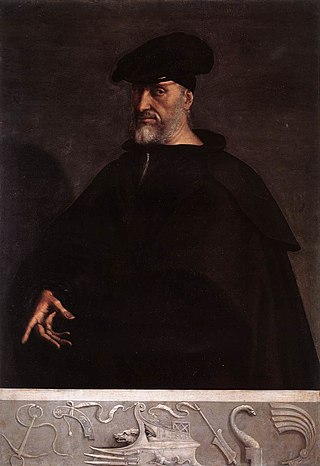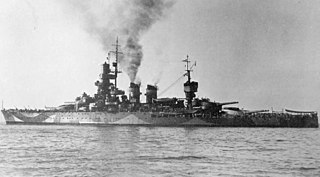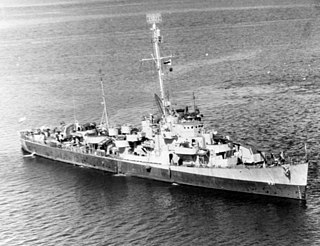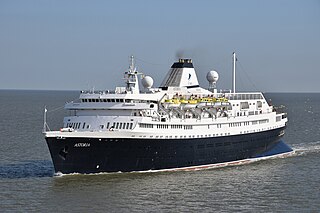Sources
This article incorporates text from the public domain Dictionary of American Naval Fighting Ships .The entry can be found here.
Two vessels of the United States Navy have been named Andrew Doria, which is the anglicized name of Italian admiral Andrea Doria.
This article incorporates text from the public domain Dictionary of American Naval Fighting Ships .The entry can be found here.

Andrea Doria, Prince of Melfi was a Genoese statesman, condottiero, and admiral, who played a key role in the Republic of Genoa during his lifetime.

SS Andrea Doriapronounced [anˈdrɛːa ˈdɔːrja], was a luxury transatlantic ocean liner of the Italian Line, put into service in 1953. She is widely known from the extensive media coverage of her sinking in 1956, which included the remarkably successful rescue of 1,660 of her 1,706 passengers and crew.

Giuseppe Garibaldi is an Italian aircraft carrier, the first through-deck aviation ship ever built for the Italian Navy, and the first Italian ship built to operate fixed-wing aircraft. Although she is widely recognised as a carrier first and foremost, she is officially designated as an aircraft-carrying cruiser. She is equipped with short take-off and vertical landing (STOVL) aircraft and helicopters. Giuseppe Garibaldi was involved in combat air operations off Somalia, Kosovo, Afghanistan and Libya.

Andrew Doria was a brig purchased by the Continental Congress in November 1775. She is most famous for her participation in the Battle of Nassau—the first amphibious engagement by the Continental Navy and the Continental Marines—and for being the first United States vessel to receive a salute from a foreign power.

A helicopter carrier is a type of aircraft carrier whose primary purpose is to operate helicopters, and has a large flight deck that occupies a substantial part of the deck, which can extend the full length of the ship like HMS Ocean of the Royal Navy (RN), or extend only partway, usually aft, as in the Soviet Navy's Moskva class or in the Chinese Navy's Type 0891A. It often also has a hangar deck for the storage of aircraft.

Vittorio Veneto was a helicopter cruiser that served with the Italian Navy. Originally intended to be a class of two ships specifically designed for anti-submarine warfare (ASW), only Vittorio Veneto entered into service in 1969, its sister ship Italia being cancelled. Vittorio Veneto was placed into reserve in 2003 and decommissioned in 2006. This ship has the same general layout as the smaller Andrea Doria-class helicopter cruisers, but with two elevators in the flight deck and the hangar below, rather than with the hangar as part of the superstructure. It was named for the decisive Battle of Vittorio Veneto which ended World War I on the Italian front.

The Andrea Doria class was a pair of dreadnought battleships built for the Royal Italian Navy between 1912 and 1916. The two ships—Andrea Doria and Duilio—were completed during World War I. The class was an incremental improvement over the preceding Conte di Cavour class. Like the earlier ships, Andrea Doria and Duilio were armed with a main battery of thirteen 305-millimeter (12.0 in) guns.

Andrea Doria was the lead ship of her class of battleships built by the Regia Marina. The class included only one sister ship, Duilio. Andrea Doria was named after the 16th-century Genoese admiral of the same name. Laid down in March 1912, the battleship was launched a year later in March 1913, and completed in March 1916. She was armed with a main battery of thirteen 305 mm (12.0 in) guns and had a top speed of 21 knots.
Andrea Doria (1466–1560) was an Italian (Genoese) admiral.

USS Edward H. Allen (DE-531) was a John C. Butler-class destroyer escort in service with the United States Navy from 1943 to 1946 and from 1951 to 1958. She was sold for scrapping in 1974.

MV Astoria is a ship that was constructed as the transatlantic ocean liner Stockholm for Swedish American Line, and rebuilt as a cruise ship in 1993. Ordered in 1944, and commenced service in 1948, at 73 years old, she is the oldest passenger liner still sailing in deep water routes. As Stockholm, she was best known for an accidental collision with Andrea Doria in July 1956, resulting in the sinking of the latter ship and 46 fatalities off the coast of Nantucket, Massachusetts, United States.

The Ruggiero di Lauria class was a class of ironclad battleships built for the Italian Regia Marina during the late 19th century. The three ships—Ruggiero di Lauria, Francesco Morosini, and Andrea Doria–were improved versions of the earlier Duilio-class ironclads. The primary improvements were new breech-loading guns, better armor protection, and more powerful machinery. The ships, designed by Giuseppe Micheli, marked a temporary diversion from the ideas of Benedetto Brin, who had designed the two preceding classes along with the following class.

Andrea Doria was an ironclad battleship built for the Italian Regia Marina in the 1880s and 1890s. Named for the 16th-century Genoese admiral Andrea Doria, she was the third and final ship of the Ruggiero di Lauria class. The ship was armed with a main battery of four 432 mm (17 in) guns, was protected with 451 mm (17.75 in) thick belt armor, and was capable of a top speed of 17 knots.

Caio Duilio is a destroyer of the Italian Navy. She and her sister Italian destroyer Andrea Doria form the Andrea Doria class; in turn these two ships, and the French vessels Forbin and Chevalier Paul, belong to the Horizon class. Caio Duilio is marked by hull number D 554 according to NATO classification.
Four ships of the Regia Marina, and the present day Italian Navy, have borne the name Duilio or Caio Duilio, the name commemorating the 3rd century BC Roman naval leader Gaius Duilius:

Andrea Doria is a destroyer of the Italian Navy. She and her sister Caio Duilio form the Andrea Doria class; in turn these two ships, and the French vessels Forbin and Chevalier Paul, belong to the Horizon class. Andrea Doria has the hull number D 553 according to NATO classification.
Andrea Doria has been borne by five ships of the Italian military and merchant navy, after Andrea Doria and may refer to:
Leonardo da Vinci (1452–1519) was an Italian Renaissance polymath.
Enrico Dandolo or simply Dandolo was the name of at least three ships of the Italian Navy named in honour of Enrico Dandolo and may refer to: